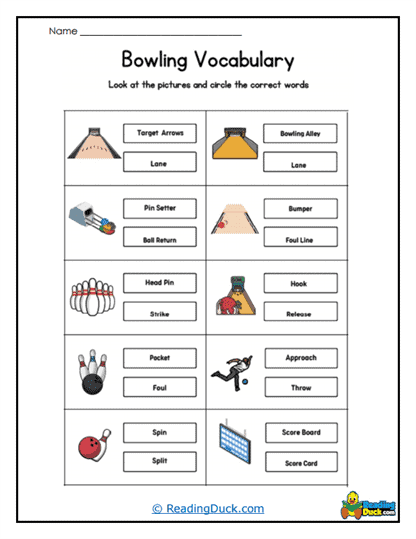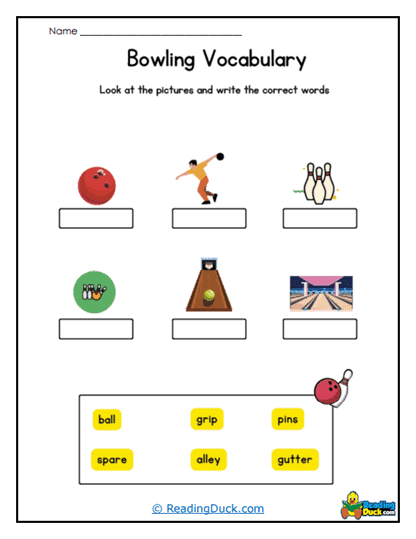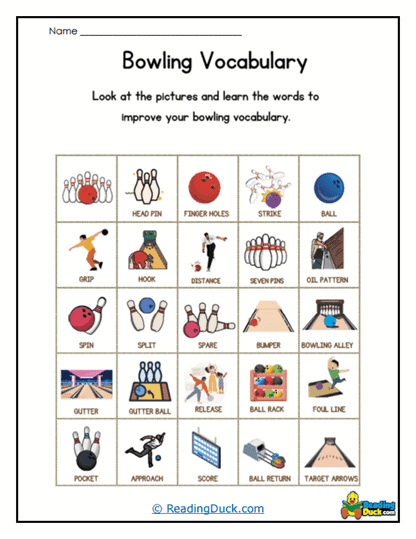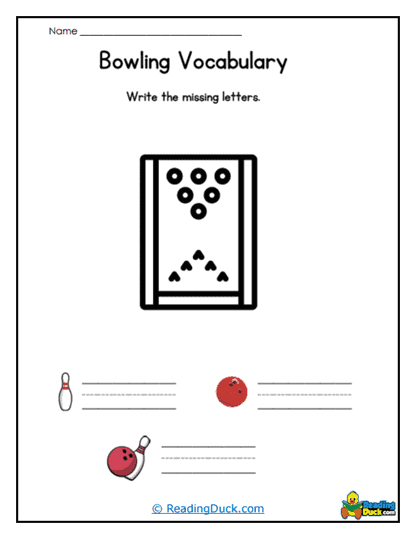Bowling Words Worksheets
About Our Bowling Vocabulary Word Worksheets
These sheets will introduce students to the common terms and phrases associated with the sport of bowling. These worksheets are more than just a tool for learning the language of bowling; they provide an engaging way for children to expand their vocabulary, improve language arts skills, and gain a deeper understanding of the sport. Teachers and homeschoolers can use these worksheets to create a multidisciplinary learning experience that blends physical education with language learning. By introducing terms like "strike," "spare," "gutter," and "frame," these worksheets not only familiarize students with the sport but also stimulate interest in bowling as a recreational or competitive activity.
One of the primary benefits of this type of work is their ability to expand a child's vocabulary. By learning specific terms used in bowling, students build a richer lexicon that enhances their overall language skills. Worksheets often include definitions, examples, and exercises such as matching words with their meanings or using them in sentences. This targeted learning approach ensures that students not only memorize new words but also understand their context and proper usage. The interactive format of the worksheets can also include word puzzles, fill-in-the-blanks, or crosswords, making the process of vocabulary building enjoyable and effective.
Completing these worksheets involves activities that require reading comprehension and writing. For instance, students might read a short passage about the rules or history of bowling and answer related questions, honing their ability to extract and process information. Writing exercises, such as crafting sentences using bowling terms or creating a short story set in a bowling alley, foster creativity while reinforcing proper grammar, sentence structure, and spelling. These tasks encourage students to engage with the material more deeply, promoting critical thinking and improving their overall literacy.
They provide an excellent opportunity to connect language arts with physical education and even mathematics. For example, teachers can introduce the scoring system in bowling to integrate basic arithmetic skills. Understanding terms like "turkey" (three strikes in a row) or "split" can tie into lessons about patterns, problem-solving, and strategy. For homeschoolers, this interdisciplinary approach ensures that students receive a well-rounded education while exploring the practical application of their new vocabulary.
When used in a classroom or homeschool co-op setting, these worksheets can encourage social and collaborative learning. Group activities, such as team-based word games or peer reviews of written assignments, help students develop communication and teamwork skills. Additionally, discussing bowling terms and concepts can spark curiosity and lead to conversations about sportsmanship, team dynamics, and the importance of physical activity. These social aspects enrich the learning experience, making it both educational and fun.
For many children, completing these worksheets builds confidence by equipping them with practical knowledge they can apply in real-life situations. Whether it's understanding the terminology during a bowling game or explaining the sport to others, students gain a sense of accomplishment and readiness. This confidence often translates into a greater willingness to participate in sports and other group activities, fostering a positive attitude toward learning and personal growth.
The worksheets are a versatile and enriching resource for teachers and homeschoolers. By combining language arts with practical knowledge and interdisciplinary connections, these worksheets help students develop essential skills while introducing them to the exciting world of bowling. The engaging format and wide-ranging benefits make them a valuable addition to any educational toolkit.
Bowling Vocabulary Words That We Explore
Strike - A strike occurs when all ten pins are knocked down with the first roll of a frame. It is the most desired outcome in bowling and earns the maximum points for that roll. Players aim to hit the pins with precision to achieve this result.
Spare - A spare is achieved when a player knocks down all ten pins within a single frame, but not with the first roll. It involves hitting the remaining pins with the second roll. Spares are essential for maintaining a high score when a strike isn't achieved.
Frame - A frame is one of the ten segments in a game of bowling during which players attempt to knock down pins. Each frame allows up to two rolls unless a strike is achieved. The tenth frame can include up to three rolls if a strike or spare is scored.
Gutter - The gutter is the channel on either side of the bowling lane. If a ball falls into the gutter, it does not hit any pins, resulting in a score of zero for that roll. Staying out of the gutter is key to maximizing points.
Split - A split occurs when two or more pins remain standing after the first roll, separated by a significant gap. Splits are notoriously difficult to convert into a spare due to the wide spacing of the pins. Common examples include the "7-10 split."
Turkey - A turkey refers to three consecutive strikes in a row during a game. Achieving a turkey is a sign of consistent precision and skill in bowling. It significantly boosts a player's score due to cumulative strike scoring rules.
Foul Line - The foul line is the boundary line at the beginning of the lane, which players must not cross while delivering the ball. Crossing the foul line results in a score of zero for that roll. Proper technique and control help players avoid fouls.
Pinsetter - A pinsetter is a mechanical device that resets the pins after each frame and clears fallen pins. Modern bowling alleys rely on automated pinsetters for efficiency. In manual setups, human pinsetters perform this task.
Hook - A hook is a ball delivery technique that curves the ball as it approaches the pins. Skilled players use hooks to increase their chances of striking the pins at an optimal angle. Hooks require precise spin and control.
Pocket - The pocket is the ideal area between pins that maximizes the chance of a strike. For right-handed bowlers, it's the space between the 1 and 3 pins, while for left-handed bowlers, it's between the 1 and 2 pins. Hitting the pocket consistently is key to high scores.
Bowling Ball - A bowling ball is the spherical object used to knock down pins. Bowling balls vary in weight, size, and material, and they often feature drilled holes for gripping. Choosing the right ball is essential for accuracy and comfort.
Bowling Lane - The bowling lane is the long, narrow surface where the ball is rolled toward the pins. It is typically made of polished wood or synthetic materials and includes an oiled section to reduce friction. Proper maintenance of the lane ensures consistent play.
Strikeout - A strikeout refers to achieving three strikes in the final (tenth) frame of a game. This feat maximizes the score for that frame and is a strong finish to any game. It is also called the "bonus frame" because of the potential for extra rolls.
Open Frame - An open frame occurs when a player fails to knock down all ten pins within a frame. This results in a lower score compared to a strike or spare. Avoiding open frames is crucial for maintaining a competitive score.
Perfect Game - A perfect game is the highest possible score in bowling, achieved by rolling 12 consecutive strikes for a total score of 300. It is a rare and celebrated accomplishment in the sport. This score requires flawless execution and consistent accuracy.









